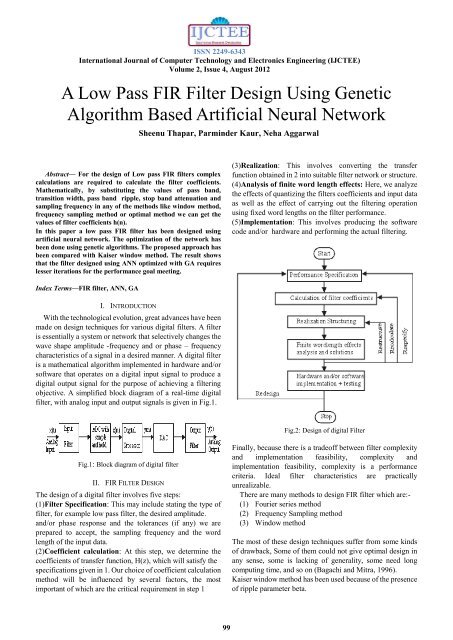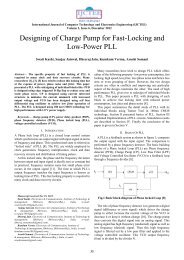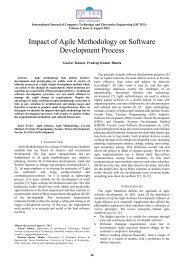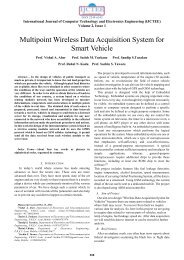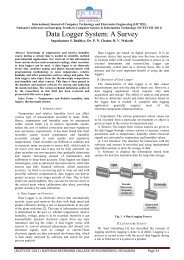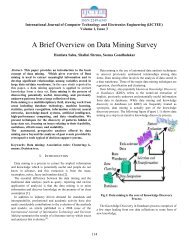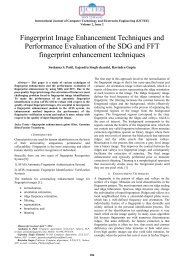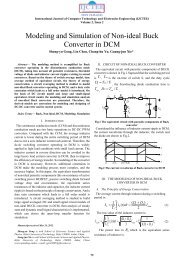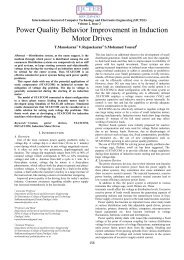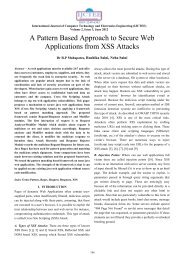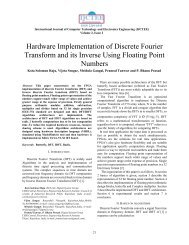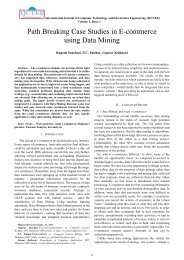A Low Pass FIR Filter Design Using Genetic Algorithm Based ...
A Low Pass FIR Filter Design Using Genetic Algorithm Based ...
A Low Pass FIR Filter Design Using Genetic Algorithm Based ...
You also want an ePaper? Increase the reach of your titles
YUMPU automatically turns print PDFs into web optimized ePapers that Google loves.
ISSN 2249-6343International Journal of Computer Technology and Electronics Engineering (IJCTEE)Volume 2, Issue 4, August 2012A <strong>Low</strong> <strong>Pass</strong> <strong>FIR</strong> <strong>Filter</strong> <strong>Design</strong> <strong>Using</strong> <strong>Genetic</strong><strong>Algorithm</strong> <strong>Based</strong> Artificial Neural NetworkSheenu Thapar, Parminder Kaur, Neha AggarwalAbstract— For the design of <strong>Low</strong> pass <strong>FIR</strong> filters complexcalculations are required to calculate the filter coefficients.Mathematically, by substituting the values of pass band,transition width, pass band ripple, stop band attenuation andsampling frequency in any of the methods like window method,frequency sampling method or optimal method we can get thevalues of filter coefficients h(n).In this paper a low pass <strong>FIR</strong> filter has been designed usingartificial neural network. The optimization of the network hasbeen done using genetic algorithms. The proposed approach hasbeen compared with Kaiser window method. The result showsthat the filter designed using ANN optimized with GA requireslesser iterations for the performance goal meeting.(3)Realization: This involves converting the transferfunction obtained in 2 into suitable filter network or structure.(4)Analysis of finite word length effects: Here, we analyzethe effects of quantizing the filters coefficients and input dataas well as the effect of carrying out the filtering operationusing fixed word lengths on the filter performance.(5)Implementation: This involves producing the softwarecode and/or hardware and performing the actual filtering.Index Terms—<strong>FIR</strong> filter, ANN, GAI. INTRODUCTIONWith the technological evolution, great advances have beenmade on design techniques for various digital filters. A filteris essentially a system or network that selectively changes thewave shape amplitude -frequency and or phase – frequencycharacteristics of a signal in a desired manner. A digital filteris a mathematical algorithm implemented in hardware and/orsoftware that operates on a digital input signal to produce adigital output signal for the purpose of achieving a filteringobjective. A simplified block diagram of a real-time digitalfilter, with analog input and output signals is given in Fig.1.Fig.2: <strong>Design</strong> of digital <strong>Filter</strong>Fig.1: Block diagram of digital filterII. <strong>FIR</strong> FILTER DESIGNThe design of a digital filter involves five steps:(1)<strong>Filter</strong> Specification: This may include stating the type offilter, for example low pass filter, the desired amplitude.and/or phase response and the tolerances (if any) we areprepared to accept, the sampling frequency and the wordlength of the input data.(2)Coefficient calculation: At this step, we determine thecoefficients of transfer function, H(z), which will satisfy thespecifications given in 1. Our choice of coefficient calculationmethod will be influenced by several factors, the mostimportant of which are the critical requirement in step 1Finally, because there is a tradeoff between filter complexityand implementation feasibility, complexity andimplementation feasibility, complexity is a performancecriteria. Ideal filter characteristics are practicallyunrealizable.There are many methods to design <strong>FIR</strong> filter which are:-(1) Fourier series method(2) Frequency Sampling method(3) Window methodThe most of these design techniques suffer from some kindsof drawback, Some of them could not give optimal design inany sense, some is lacking of generality, some need longcomputing time, and so on (Bagachi and Mitra, 1996).Kaiser window method has been used because of the presenceof ripple parameter beta.99
ISSN 2249-6343International Journal of Computer Technology and Electronics Engineering (IJCTEE)Volume 2, Issue 4, July 2012Fig.6: Performance PlotFig 4. Error GraphFigure shows that the ann response is better than the actualresponse and the error is reduced to a large amount.The Input Data Set taken is TW =52 , SF = 1.3 , PBR = 0.12 ,N=4, PBF=151,SBT=9.9413.The ANN has been optimized using GA. The results obtainedare shown in Fig 4,5 & 6Fig. 7: Regression PlotFig 5 : Neural Network TrainingFig.8: Training State102
ISSN 2249-6343International Journal of Computer Technology and Electronics Engineering (IJCTEE)Volume 2, Issue 4, August 2012VII. CONCLUSIONThe present thesis has illustrated the need of Artificial NeuralNetwork for the design of low pass <strong>FIR</strong> <strong>Filter</strong>s rather thanusing the complex calculative Window method..The following conclusions are drawn from this researchwork:(1) Artificial Neural Network is better and easy method of<strong>Design</strong> of low <strong>Pass</strong> <strong>FIR</strong> <strong>Filter</strong>.(2) <strong>Using</strong> Fourier series, Frequency sampling or Windowmethods the filter can be design but for each unknownparameter the filter coefficients have to calculated. Incomparison with ANN, the trained network can calculate thefilter Coefficient for unknown parameter in that specifiedrange.(3) The error graphs shows that results come from Kaiserwindow method and artificial neural network is almost same.(4) The ANN optimized with GA is meeting theperformance goal in just 7 iterationsREFERENCES[1] Aggarwal Varun., Jin O Wesley and May O Una., (2006) “<strong>Filter</strong>approximation using Explicit Time and Frequency Remainspecification”. Proceeding, of the Annual Symposium on ArtificialIntelligence, 2006, Seattle, Washington, pp. 174–165.[2] Aktan Mustaf,Yurdakul Arda and Dundar Gunhan (2008),”An<strong>Algorithm</strong> for the design of <strong>Low</strong> –power hardware –Efficient <strong>FIR</strong> filterIEEE transaction on circuit and systems vol 55 No.,2008,pp1536-1545.[3] C. Y. Lin, M. Wu, J. A. Bloom, I. J. Cox, and M. Miller, “Rotation,scale, and translation resilient public watermarking for images,” IEEETrans. Image Process., vol. 10, no. 5, pp. 767-782, May 2001.[4] A. Fizelow., P. Brites., A. Ochoa., H. Mertuns., E. Fernandez, andGarcia-Martinez R. (2007) “Finding Optimal Neural NetworkArchitecture using <strong>Genetic</strong> <strong>Algorithm</strong>s,” Proceeding of the advances incomputer and Engineering, 2007, pp. 15–24.[5] Bhattacharya D. and Antoniou A., (1996) “Real Time <strong>Design</strong> of <strong>FIR</strong><strong>Filter</strong>s of Feedback Neural Network”, Vol. 3, 1996, pp 1070.[6] Durrani A. Yasur and Riesgo Teresa., (2007) “LUT-based PowerMacro modeling Technique for DSP architectures”, Proceeding of theIEEE, Centro de Electronica Industrial, Spain, August, 2007, pp.1416–1419.[7] Englihart K.B., Hudgins B. S., Stevenson M. and Parker P. A., (1994)“Myoelectric Signal Classification using a Finite Impulse ResponseNeural Network”. Technical Report, The university of NewBrunswork, Canada, June, 1994, pp. 803–820.[8] Fan Z. and Mars P., (1997) “Access flow control scheme for ATMnetworks using neural-network-based traffic prediction”. Proceedingfor IEEE, Vol. 144, Dec. 5, October 1997, pp. 708–714.[9] Garimella Rama Marthy. (2008) “Finite Impulse Response <strong>FIR</strong> filterModel of Synapses: Associated Neural Network”, Proceeding of theFourth Annual IEEE International Confidences on NaturalComputation, 2008, pp. 3304–3309.[10] Gua Zichao and Uhrig E. Robert., (1992) “<strong>Using</strong> <strong>Genetic</strong> <strong>Algorithm</strong>sto select input for Neural Network”. Proceeding of the IEEEInternational conference, May, 1992, pp. 87–95.[11] Hintz K. J. and Spofford J. J., (1990) “Evoling Neural Network”Proceedings of the IEEE Transactions on Communication andIntelligence, May 1990, pp. 333–338.[12] Haykins, S. (2003), “Neural Networks – A comprehensivefoundation”, Prentice – Hall of India Private Limited, New Delhi 2003.[13] Ileană Ioan., Rotar Corina and Incze Arpad., (2004) “The optimizationof feedforward”, proceedings of the international and information –ICTAMI 2004, Thessalo-niki, Greece.[14] I feachor Emmonual C. and Jervis Barriel W. (2001) “Digital SignalProcessing,” A Practical Approch,” Person Education (Singapore)Ltd., 2001, Second Edition.[15] Jou Yue-Dar. and Chen Fu-Kun., (2007) “Least square <strong>Design</strong> of <strong>FIR</strong><strong>Filter</strong>s based on a compacted Feedback Neural Network”, Proceedingof the IEEE Transaction on Circuits and systems, vol. 54 issue 5, May,2007, pp. 427–431.[16] D. Suckley, (1991) “ <strong>Genetic</strong> <strong>Algorithm</strong> in the design of <strong>FIR</strong> filters” IEEProceedings in Circuits, Devices & Systems, Vol. 138, issue 2, pp.234-238.AUTHOR’S PROFILE:Sheenu Thapar is currently Assistant Professor in ECE Department,Continental Institute of Engineering & Technology, Fatehgarh Sahib,140407,India. (e-mail: sheenukuk@gmail.com).Parminder Kaur is currently Assistant professor in ECE Department, DeshBhagat Engineering College, Mandi Gobindgarh, 147301, India. (e-mail:parminderkaurece@gmail.com).Neha Aggarwal is currently Assistant professor in ECE Department, DeshBhagat Engineering College, Mandi Gobindgarh, 147301, India. (e-mail:Er.neha_14@yahoo.com).103


